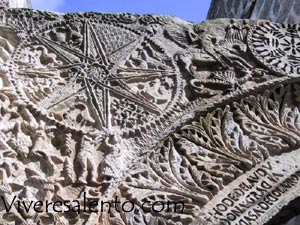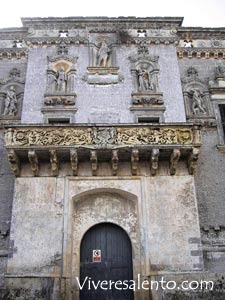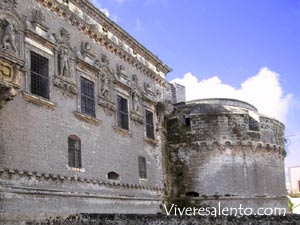|
|

| Inhabitants'
name: Coriglianesi |
The civic coat of arms of Corigliano is characterised by a
red heart and a Latin inscription telling us that our
 strength
lies in our heart. We do not know exactly when the village was founded and whom
it is named after. The legend says it could be Corileo, the son of a Greek king,
who was exiled and had to leave Greece. Some scholars do not agree because the
Greeks used to set themselves along the coasts and Corigliano is too far from
the sea. This village could also be named after Marcio Coriolano, a Roman consul
who was exiled from Rome because of his bad behaviour. He wanted to join the
Volsci to fight against the Romans, then his wife and his mother made him change
his mind and he gave up fighting. The people of Corigliano named the village
after him in order to show him their thankfulness. Those are only two legends
about the origin of Corigliano but we know that from the 6th and the 10th
century it was strongly influenced by the Greek domination. Signs of their
presence in this area have survived through strength
lies in our heart. We do not know exactly when the village was founded and whom
it is named after. The legend says it could be Corileo, the son of a Greek king,
who was exiled and had to leave Greece. Some scholars do not agree because the
Greeks used to set themselves along the coasts and Corigliano is too far from
the sea. This village could also be named after Marcio Coriolano, a Roman consul
who was exiled from Rome because of his bad behaviour. He wanted to join the
Volsci to fight against the Romans, then his wife and his mother made him change
his mind and he gave up fighting. The people of Corigliano named the village
after him in order to show him their thankfulness. Those are only two legends
about the origin of Corigliano but we know that from the 6th and the 10th
century it was strongly influenced by the Greek domination. Signs of their
presence in this area have survived through the centuries, for instance, the elderly people can still speak ‘griko’, a kind
of Greek dialect. A group of Basilian monks arrived in Corigliano during the
Greek domination and wrote many important codes, some of them are preserved in
the Ambrosian library in Milan and in the Vatican library. The Basilian monks
had to leave Corigliano in the 10th century, they found shelter in Otranto but
the Greek rite was celebrated until the 17th century. According to some
historical documents, King Tancredi gave the village to the Drinis in 1192
during the Norman domination. Afterwards it was ruled by the Sanfelices, the
Ceppoys and the Tremblays. In the 15th century it was sold to the D’Enghiens and
later to the Orsini del Balzos. During the domination of the Aragonese it was
ruled again by the Drinis and, when the last heir had died, Ferdinand of Aragon
gave it to the De Montis who sold it to the Tranis. The last family to rule
Corigliano were the Pignatellis because in 1806 the feudal system came to end.
Among the famous people who came from Corigliano we remember: Panfilo Cosma, a
talented doctor and appreciated physicist. In 1604 he translated a manuscript
about the life of Saint Irene by the Bishop of Smirne from Greek into Latin.
Andrea Peschiulli was born in 1601 in a wealthy family. He was interested in
the centuries, for instance, the elderly people can still speak ‘griko’, a kind
of Greek dialect. A group of Basilian monks arrived in Corigliano during the
Greek domination and wrote many important codes, some of them are preserved in
the Ambrosian library in Milan and in the Vatican library. The Basilian monks
had to leave Corigliano in the 10th century, they found shelter in Otranto but
the Greek rite was celebrated until the 17th century. According to some
historical documents, King Tancredi gave the village to the Drinis in 1192
during the Norman domination. Afterwards it was ruled by the Sanfelices, the
Ceppoys and the Tremblays. In the 15th century it was sold to the D’Enghiens and
later to the Orsini del Balzos. During the domination of the Aragonese it was
ruled again by the Drinis and, when the last heir had died, Ferdinand of Aragon
gave it to the De Montis who sold it to the Tranis. The last family to rule
Corigliano were the Pignatellis because in 1806 the feudal system came to end.
Among the famous people who came from Corigliano we remember: Panfilo Cosma, a
talented doctor and appreciated physicist. In 1604 he translated a manuscript
about the life of Saint Irene by the Bishop of Smirne from Greek into Latin.
Andrea Peschiulli was born in 1601 in a wealthy family. He was interested in
 several
subjects for instance theology, Greek, philosophy and medicine. He was usually a
guest of the De Montis and this friendship caused him many troubles. When
Ferrante De Monti was considered as one of those who had conspired against the
Spanish government and was beheaded, Andrea Peschiulli had to run away. After
several stops he went to Venice where he was a well-known person and has been a
guest of Giovan Francesco Loredano. He left Venice short after and went to Genoa
where he had the help of the Franzonis. He wrote several books, had 7 children
and died in Rome in 1691. Scipione De Monti was born in 1525 and was son of
Giovan Battista De Monti. He was very interested in military subjects and wrote
several books and a collection of lyrics. several
subjects for instance theology, Greek, philosophy and medicine. He was usually a
guest of the De Montis and this friendship caused him many troubles. When
Ferrante De Monti was considered as one of those who had conspired against the
Spanish government and was beheaded, Andrea Peschiulli had to run away. After
several stops he went to Venice where he was a well-known person and has been a
guest of Giovan Francesco Loredano. He left Venice short after and went to Genoa
where he had the help of the Franzonis. He wrote several books, had 7 children
and died in Rome in 1691. Scipione De Monti was born in 1525 and was son of
Giovan Battista De Monti. He was very interested in military subjects and wrote
several books and a collection of lyrics.
|